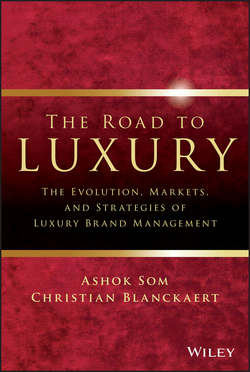Читать книгу The Road To Luxury - Blanckaert Christian - Страница 12
На сайте Литреса книга снята с продажи.
Chapter 1
Introduction
Definition and Crisis of Luxury
Effect of Crisis on the Luxury Industry
ОглавлениеThe luxury world was a place where no one expected to perish. And then suddenly Christian Lacroix rang its bell – investors collapsed in the face of the coming of Louis Vuitton and Céline and were obliged to leave the company when the shareholders of Escada refused to inject the fresh capital required to turn around the company.
On the other hand, consider the resurrection of the legendary Italian haute couture house Schiaparelli, known for the introduction in the 1920s of women's shorts, colored zip fastenings, and catwalk shows. After being shut down since World War II, it was repurchased in 2009 by Diego Della Valle and relaunched in 2012. Diego Della Valle, the chairman of Tod's Group who also revived the famous brand Roger Vivier, has brought Schiaparelli back on the stage of the fashion business after more than 60 years. This is not the only case in the luxury world. The almost immortal vitality and endless potential of a luxury brand can never be compared to any other normal brands.
The crisis was a wake-up call for the luxury industry. All métiers were hit by the 2009 recession but not at the same level. The métiers reacted in different ways. Watches were showing the most profound weakness, decreasing in all markets to the tune of 20 percent, which scared the Swiss and most other brands. Jewelry followed with a decrease of 15 to 20 percent. Arts de la table fell at least 20 percent or much more. Ready-to-wear for women and men fell 10 to 20 percent depending on the brands, and even perfumes fell between 7 to 15 percent. It affected L'Oréal, Estée Lauder, Clarins, and their competitors. The most resilient were leather goods, which explains the consistency of Louis Vuitton, Goyard, Hermès, and, within the brands, Chanel, Gucci, and Dior bags and other leather goods.
Overall, the watches and jewelry segment faced a mixed reaction. While the recession was known to hit the watch industry the worst, some people still invested in the Rolex brand in times of crashing stock markets and devaluing currency. Luxury houses like LVMH were known to have fared better than the likes of Richemont, because LVMH, through TAG Heuer, invested in hard luxury versus Richemont, which focused on soft luxury. Brands like Hermès, Swatch, Chopard, Hublot, and De Beers faced declining profits, whereas Dior fared well in the watches and jewelry sector. However, industry figures depicted a decline of 31.9 percent in June 2009 and a slowdown in the summer of 2013 due to unfavorable economic climate in Europe and in China. Swiss exports of watches declined, indicating that it was an industry-wide phenomenon.
For the wines and spirits sector, brands like Diageo, Moët & Chandon, Pernod Ricard, and Rémy Martin all reported a significant decline in profits. Diageo, which was more exposed in Ireland and Greece at the time they were saddled by the debt crisis, was the worst hit of all, indicating a strong negative impact on sales.
Luxury cosmetic and fragrance brands were hit by the recession, too. Estée Lauder and L'Oréal slid into the red, and undertook significant cost-cutting operations. The recession hit this segment in part because women tend to stock beauty products and perfumes. During times of recession, they usually fall back on the stock they have built over the years. However, some companies managed to stay profitable, including Sephora, Revlon, and Sally Beauty.
The crisis was affecting other brands, especially in the field of arts de la table. In 2009, Lalique, Daum, Baccarat, Cristalleries de Saint Louis, and many others suffered a great deal. On the other hand, 2009 was a very interesting period that tested the strengths and weaknesses of the sector. The conglomerates showed poor figures compared to the bright numbers posted year after year for the previous 10 years. Sales of brands such as Burberry, Armani, and Cartier – including the whole Richemont Group – suffered. Hermès, Louis Vuitton, and Prada were probably the most successful survivors; in fact they were winners in terms of announcing positive figures of sales.
The crisis was for real as far as the luxury world was concerned. The response of the luxury sector revealed to the analysts, researchers, investors, and other stakeholders that luxury was sensitive to the economic situation of the global world, just like every other sector. In fact, no one could pretend that luxury was invincible, and rich investors realized that the niche aspect of luxury was fading away. This was in fact the consequence of the evolution of the luxury world. Not only big and financially strong conglomerates with millions of customers faced the crisis – it was also faced by small family-owned players in the luxury business. They were all affected by the crisis and the stock market.
